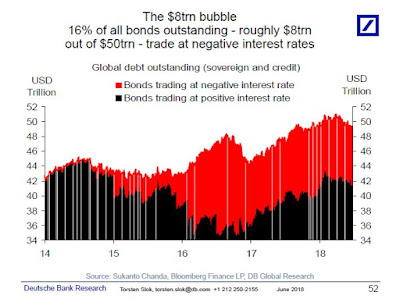In three and a half years, the world debt has gone from being a worry to a bubble. At the end of 2014, there were just under $44 trillion worth of corporate and government debt on issue with roughly 1.4 percent of these yielding negative rates. As of June 2018, there are now more than $49 trillion worth of corporate and public sector bonds in the markets, with ca $8 trillion of these (or 16 percent) trading at negative yields.

And this is just a part of the overall debt bubble picture. In April this year, the IMF report noted that non-bank funding for households and wholesale lending "is on the rise since the Lehman-crisis, and constitutes a major source of bank credit to the economy" (see https://www.imf.org/en/Publications/WP/Issues/2018/03/19/Leverage-A-Broader-View-45720). IMF estimates for non-bank funding for the U.S. banks alone, shown below, add $11.7 trillion to the debt system in 2016, against $10 trillion in 2008. Meanwhile, another roughly $8 trillion worth of non-bank debt is sitting in the dealer funds and hedge funds' pledged collateral exposures.
Meanwhile, in the U.S. alone, $6.3 trillion corporate debt bubble is now at a risk of rising interest rates. U.S. speculative-grade corporate borrowers are now at a new record-low cash-to-debt ratio of just 12 percent, below the 14 percent in 2008. Worse, per S&P report, more than 450 investment-grade companies that are not in the top 1 percent of cash-rich debt issuers, have highly risky cash-to-debt ratios of around 21 percent....
[1]
